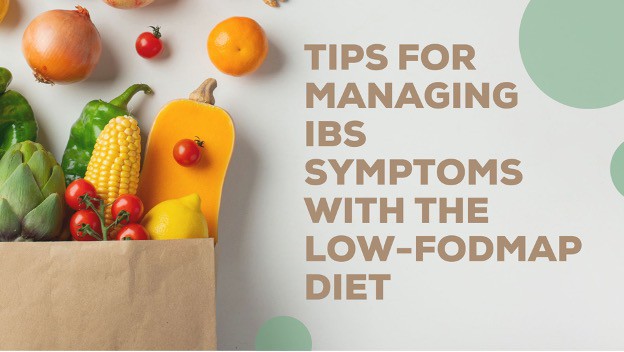Millions of people worldwide are affected by Irritable Bowel Syndrome (IBS). It can cause uncomfortable and disruptive symptoms. Symptoms include abdominal pain, bloating, and changes in bowel movements. While there is no cure for IBS, there are ways to manage symptoms, including dietary changes.

One popular approach is the low-FODMAP Diet. A low-FODMAP diet involves avoiding certain carbohydrates that can contribute to IBS symptoms. In this article, we’ll explore some tips for managing IBS symptoms with the low-FODMAP diet.
1. Use helpful resources
Many resources, including books, websites, and apps, are available. These resources will help you navigate the low-FODMAP diet. These resources can provide valuable information on the diet. It includes a list of high- and low-FODMAP foods, recipes, and meal plans.
The low-FODMAP diet for Beginners book and the FODMAP Friendly app is also popular. Some popular resources include the Monash University FODMAP app. These resources let you be more informed about the diet and better manage your IBS symptoms.
2. Identify low-FODMAP foods.
The low-FODMAP diet involves avoiding certain carbohydrates. Carbohydrates that can contribute to IBS symptoms. Foods like wheat, onions, garlic, apples, and honey. They contain fermentable oligosaccharides, disaccharides, monosaccharides, and polyols, which are FODMAPs.
Many foods with low-FODMAP content are safe to consume on a diet. Below are some instances of foods that have a low-FODMAP content:
- Meat: beef, chicken, lamb, pork, turkey, and fish are all low in FODMAPs.
- Eggs: eggs are a good source of protein and are low in FODMAPs.
- Dairy: lactose-free milk; hard cheeses such as cheddar and Swiss; Yogurts made from lactose-free milk are all low in FODMAPs.
- Grains: gluten-free grains such as rice, quinoa, and corn are all low in FODMAPs.
- Fruits: low-FODMAP fruits include bananas, blueberries, grapes, kiwi fruit, oranges, and strawberries.
- Vegetables: low-FODMAP vegetables include carrots, cucumbers, lettuce, tomatoes, and zucchini.
Remember that the size of a food serving can determine whether it is low or high in FODMAPs. Working with a registered dietitian can greatly help you. They will help identify which low-FODMAP foods you can consume in larger amounts. They will help identify the limit of low-FODMAP you’ll consume.
Cooking methods can also affect FODMAP content. So learning how to prepare low-FODMAP foods to minimize FODMAP intake is essential. Identifying low-FODMAP foods will help create a balanced and varied diet. A diet that is rich in nutrients and free from trigger foods.
3. Avoid high-FODMAP foods
Avoiding high-FODMAP foods is crucial for managing IBS symptoms with the low-FODMAP diet. high-FODMAP foods can trigger symptoms. Symptoms include gas, abdominal pain, diarrhea, and bloating. It’s essential to be aware of the foods high in FODMAPs and avoid or limit them in your diet.
Here are some tips for avoiding high-FODMAP foods:
- Educate yourself on high-FODMAP foods: Learn which foods are high in FODMAPs and which are not. Some common high-FODMAP foods include wheat, rye, barley, onions, garlic, and beans. Also, lentils, chickpeas, cashews, pistachios, apples, pears, mangoes, watermelons, and mushrooms.
- Read food labels: When grocery shopping, read the ingredient list on food labels. Avoid foods that contain high-FODMAP ingredients. For example, high fructose corn syrup, inulin, and wheat.
- Choose low-FODMAP alternatives: low-FODMAP alternatives are available for many high-FODMAP foods. For example, use chives instead of onions. Instead of garlic-infused oil, use garlic in your cooking. Instead of eating wheat bread, opt for sourdough or gluten-free bread.
- Pay attention to serving sizes: You may consume some high-FODMAP foods in small amounts without triggering symptoms. It’s essential to pay attention to recommended serving sizes. Pay attention to how your body reacts to different portions of high-FODMAP foods.
- Be mindful when dining out: It can be challenging to avoid high-FODMAP foods. Look for menu items that are low-FODMAP. Ask the server if the restaurant can accommodate your dietary needs.
Avoiding high-FODMAP foods can reduce the likelihood of triggering symptoms. Avoiding high-FODMAP foods also helps manage your IBS. Working with a healthcare professional, such as a registered dietitian, is vital. They will help you create a personalized meal plan that meets your nutritional needs. They’ll create a personalized meal plan while managing your IBS symptoms.
4. Work with healthcare professionals.
Suppose you are considering the low-FODMAP diet, working with a healthcare professional is essential for guidance and support. A registered dietitian will help you create a personalized meal plan. A customized diet plan that addresses your nutritional requirements while also addressing your IBS symptoms.
They will also help you identify trigger foods and provide tips for managing symptoms.
5. Make lifestyle changes
In addition to dietary changes, you can make other lifestyle changes. This will help you manage your IBS symptoms better. Managing IBS includes exercise, stress reduction, and sleep. By making these changes, you can improve your health and reduce the impact of IBS on your life.
6. Experiment with low-FODMAP foods
While the low-FODMAP diet can effectively manage IBS symptoms, it’s essential to remember that each person’s body is different. Some people may find that certain low-FODMAP foods still trigger symptoms. Some individuals may have a higher tolerance for those foods.
By experimenting with different low-FODMAP foods, you can find what works best for your body. This will help you create a personalized diet that meets your needs.
7. Keep a food diary
Keeping a food diary is essential to managing IBS symptoms with the low-FODMAP diet. Identify trigger foods and adjust your diet. Do this by tracking your food intake and symptoms.
Here are some suggestions for keeping a food diary:
- Use a notebook or an app: You can keep a food diary in a notebook or use an app. Apps that are specifically designed for tracking food and symptoms can help you track your diet and symptoms.
- Be consistent: You need to be consistent. This will help get an accurate picture of how your diet affects your symptoms. Consistency in tracking is crucial. Record what you eat, how much you eat, when, and any symptoms you experience.
- Record your symptoms: Aside from tracking your diet, record any symptoms you experience. Include the type and severity of the symptoms and when they occurred. Recording can help you identify patterns and triggers.
- Be honest: It’s essential, to be honest with yourself when keeping a food diary. Record everything you eat, even if you know it’s a trigger food. Being honest can help you identify which foods are causing the most symptoms. By doing so, you can make necessary changes to your diet.
- Use it as a tool: Use your food diary to help you identify trigger foods and adjust your diet. Tracking your diet and symptoms can help you understand how your body reacts to certain foods. Keeping track of your diet can assist you in making informed choices about your food selection.
Conclusion
While there is no cure for IBS, the low-FODMAP diet can be a useful approach. This will help manage IBS symptoms. But it’s important to approach it with care and support from healthcare professionals.
By using helpful resources, identifying low- and high-FODMAP foods, making lifestyle changes, experimenting with different foods, and keeping a food diary, you can better manage your IBS symptoms and improve your overall quality of life.
Remember to work closely with a healthcare professional. They will prioritize finding what works best for you. With time, patience, and experimentation, you can find what works best for your body and live a more comfortable life with IBS.
Digital Health Buzz!
Digital Health Buzz! aims to be the destination of choice when it comes to what’s happening in the digital health world. We are not about news and views, but informative articles and thoughts to apply in your business.


